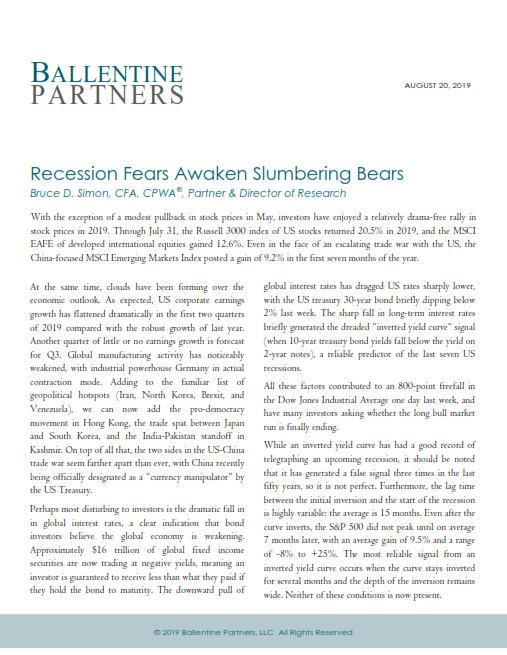 With the exception of a modest pullback in stock prices in May, investors have enjoyed a relatively drama-free rally in stock prices in 2019. Through July 31, the Russell 3000 index of US stocks returned 20.5% in 2019, and the MSCI EAFE of developed international equities gained 12.6%. Even in the face of an escalating trade war with the US, the China-focused MSCI Emerging Markets Index posted a gain of 9.2% in the first seven months of the year.
With the exception of a modest pullback in stock prices in May, investors have enjoyed a relatively drama-free rally in stock prices in 2019. Through July 31, the Russell 3000 index of US stocks returned 20.5% in 2019, and the MSCI EAFE of developed international equities gained 12.6%. Even in the face of an escalating trade war with the US, the China-focused MSCI Emerging Markets Index posted a gain of 9.2% in the first seven months of the year.
At the same time, clouds have been forming over the economic outlook. As expected, US corporate earnings growth has flattened dramatically in the first two quarters of 2019 compared with the robust growth of last year. Another quarter of little or no earnings growth is forecast for Q3. Global manufacturing activity has noticeably weakened, with industrial powerhouse Germany in actual contraction mode. Adding to the familiar list of geopolitical hotspots (Iran, North Korea, Brexit, and Venezuela), we can now add the pro-democracy movement in Hong Kong, the trade spat between Japan and South Korea, and the India-Pakistan standoff in Kashmir. On top of all that, the two sides in the US-China trade war seem farther apart than ever, with China recently being officially designated as a “currency manipulator” by the US Treasury.
Perhaps most disturbing to investors is the dramatic fall in in global interest rates, a clear indication that bond investors believe the global economy is weakening. Approximately $16 trillion of global fixed income securities are now trading at negative yields, meaning an investor is guaranteed to receive less than what they paid if they hold the bond to maturity. The downward pull of global interest rates has dragged US rates sharply lower, with the US treasury 30-year bond briefly dipping below 2% last week. The sharp fall in long-term interest rates briefly generated the dreaded “inverted yield curve“ signal (when 10-year treasury bond yields fall below the yield on 2-year notes), a reliable predictor of the last seven US recessions.
All these factors contributed to an 800-point freefall in the Dow Jones Industrial Average one day last week, and have many investors asking whether the long bull market run is finally ending.
While an inverted yield curve has had a good record of telegraphing an upcoming recession, it should be noted that it has generated a false signal three times in the last fifty years, so it is not perfect. Furthermore, the lag time between the initial inversion and the start of the recession is highly variable: the average is 15 m
onths. Even after the curve inverts, the S&P 500 did not peak until on average 7 months later, with an average gain of 9.5% and a range of -8% to +25%. The most reliable signal from an inverted yield curve occurs when the curve stays inverted for several months and the depth of the inversion remains wide. Neither of these conditions is now present.
One plausible non-recession explanation for the curve inversion is based upon the appeal of US debt relative to the negative yields available on other sovereign bonds. In a world of sub-zero interest rates, 1.5% on a US government bond sounds pretty good.
Taken together, we view the brief period of inversion last week as an indicator to monitor, but not an imminent recession signal.
Other measures of economic health remain solidly positive in the United States. Consumer spending remains robust, unemployment rates hover near all-time lows, wages are growing in real terms, and inflation remains subdued. Traditional leading measures of economic activity (e.g. building permits, light truck sales, credit conditions, etc.) remain reasonably healthy.
As we approach the 2020 election, one should not overlook the power of the “Trump Put”, the ability of the president to stimulate the economy in order to improve his chances for reelection. This could include putting additional pressure on Chairman Powell to institute more monetary easing, implementing policies to put downward pressure on the dollar, enacting another tax cut, and/or dialing back the trade war with China. While the president’s ability to influence the economy can be overstated, he does have a number of tools at his disposal to impact economic activity (and the stock market) in the short run.
We expect the recent surge in market volatility to persist for a while, as investors search for clues on the future direction of economic growth. We believe our modest overweight to US equities is appropriate given the economic challenges facing Europe and China. At present, we do not see the conditions necessary for a US recession, and are maintaining our current neutral allocation to equities.
Learn more about Bruce Simon, our Director of Research.
This report is the confidential work product of Ballentine Partners. Unauthorized distribution of this material is strictly prohibited.
The information in this report is deemed to be reliable but has not been independently verified. Some of the conclusions in this report are intended to be generalizations. The specific circumstances of an individual’s situation may require advice that is different from that reflected in this report. Furthermore, the advice reflected in this report is based on our opinion, and our opinion may change as new information becomes available.
Nothing in this presentation should be construed as an offer to sell or a solicitation of an offer to buy any securities. You should read the prospectus or offering memo before making any investment. You are solely responsible for any decision to invest in a private offering.
The investment recommendations contained in this document may not prove to be profitable, and the actual performance of any investment may not be as favorable as the expectations that are expressed in this document. There is no guarantee that the past performance of any investment will continue in the future.





